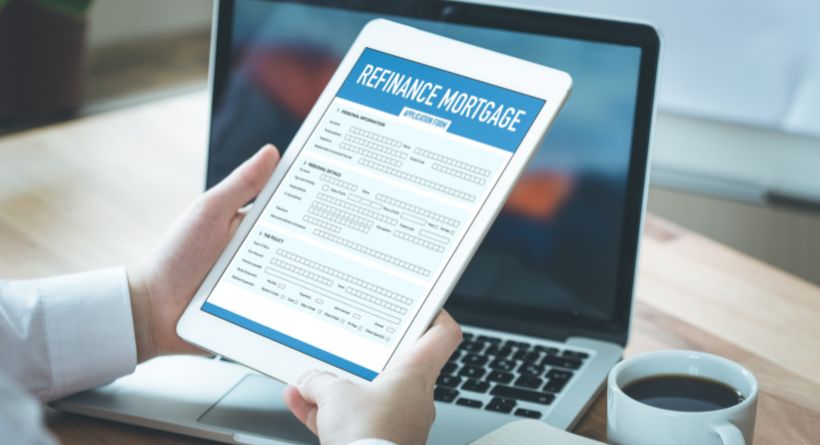Today’s Mortgage Refinance Rates
The average 30-year fixed refinancing loan APR stayed constant from yesterday at 7.21%. The 30-year fixed APR was 7.16% last week at this time. In the meanwhile, the average interest rate on a 15-year fixed refinancing mortgage is 6.48%. Last week at this time, the 15-year fixed-rate mortgage APR was 6.38%.
The 30-year fixed-rate jumbo mortgage refinancing average APR is 7.21%. The average 30-year jumbo loan APR was 7.20% last week. The average interest rate on a 5/1 ARM refinancing is 6.88%. The average APR on a 5/1 ARM was 6.83% last week.
What Experts Say About Current Refinance Rates
By the end of the year, most housing and mortgage experts expect that refinancing rates will be between 5% and 6%. As mortgage refinancing interest rates rise in 2022, it will be less enticing for mortgage borrowers to renew their loan if their new rate is near to the one they’re currently paying—especially after factoring in the closing fees to refinance.
For the remainder of the year, here are some mortgage refinancing rate forecasts:
“With mortgage rates at their highest levels since 2008, the chance for most homeowners to refinance into a cheaper rate has basically passed,” says Danielle Hale, chief economist for Realtor.com. From now through the end of 2022, Hale forecasts rates to remain between 5.5% and 6%.
According to Mike Fratantoni, chief economist for the Mortgage Bankers Association (MBA), interest rates may have already peaked this year, providing a chance for a few homeowners to refinance.
Rates “may continue between 5% and 5.5% for the rest of 2022,” he believes.
Who Offers the Lowest Refinance Rates?
Start with our list of the top mortgage refinancing lenders to obtain the best refinance rates. Just bear in mind that some of the rates you see online may not apply in every case, such as if you have a credit score that is either lower or higher than normal. You may also attempt to negotiate a better rate with your existing lender by searching around and presenting some solid offers on loan rates and conditions from other lenders.
Best Mortgage Refinance Companies
Because mortgage rates are still relatively low, homeowners still have time to refinance and cut their monthly mortgage payments. Homeowners who want to save money by locking in a lower rate, shorten their mortgage term, or access part of their home equity without selling their property should analyse the figures to determine whether refinancing makes sense.
Before refinancing your house, look around for a lender that will provide you the best interest rate and repayment conditions. Forbes Advisor examined the top refinancing lenders. These firms provide some of the most competitive rates and fees, which are important considerations when refinancing.
Three Steps to Obtaining the Lowest Refinance Rate
Most mortgage refinances aim to reduce your interest rate and maximise your savings. Naturally, the lower the interest rate, the greater the savings.
However, just because a lender offers a given rate does not guarantee that you will qualify for it. Often, lenders may publicise their lowest possible rate, but such prices are reserved for applicants who meet certain requirements, such as having a good credit score and a low loan-to-value ratio.
Borrowers may improve their chances of getting the best rate by completing three simple things:
1. Improve Your Credit Score
If your credit score is less than 760, you may not be eligible for the greatest interest rate lenders have to offer. That doesn’t mean you can’t obtain a lower rate than you have now, but there is potential to improve your credit and increase your savings. Check your credit score and get a copy of your credit report before applying for a mortgage refinancing.
If you discover any problems on your credit report, notify both the credit agency and the company that committed the error as soon as possible. Both parties must alter the information for it to appear on your credit report and affect your credit score.
You may improve your credit score by paying off credit card debt and limiting your usage of credit cards. If you do use credit cards for rewards and points, attempt to pay them off as soon as possible—don’t wait for your monthly bill since your credit score might fluctuate on a daily basis.
Avoid opening new lines of credit before applying for a mortgage refinancing, since credit applications might lower your credit score. However, completing numerous mortgage applications in an attempt to get the lowest feasible rate will not harm your credit score.
Numerous mortgage applications during the same time period are counted as one application by credit bureaus since they perceive such behaviour as comparison shopping rather than attempting to obtain multiple lines of credit.
2. Look around for the best deal
Shopping around is the second step in ensuring you obtain the best deal possible? Make careful to compare the APR, not just the rate, across lenders. The APR is the sum of your mortgage charges, which will include your closing fees if they are folded into your loan.
Before making a selection, you should evaluate offers from at least three lenders. Consider the following two situations when comparing interest rates and APR:
If you want to remain in your house for a lengthy period of time, finding the best mortgage rate may be more significant than spending the least amount of money in closing expenses.
If you don’t intend to remain for more than a couple of years, pay particular attention to the lender’s loan projections, which will show you the expected five-year cost. Select the deal with the lowest starting cost.
3. Maintain a low loan-to-value ratio
Finally, the smaller the loan-to-value ratio, the lower the interest rate. If you don’t have to take cash out of your property to refinancing, you should avoid doing so since it will increase your LTV and most likely result in a higher interest rate.
The loan-to-value ratio compares the amount of finance utilized to purchase a property to the home’s worth. Maximum loan-to-value (LTV) ratios vary depending on the kind of property you’re refinancing, whether the loan is fixed-rate or adjustable-rate mortgage (ARM), and whether you’re performing a regular refinance or a cash-out refi.
The Benefits and Drawbacks of Refinancing
If you can decrease your monthly mortgage payment by lowering your interest rate or lengthening your loan term, you might consider refinancing your mortgage. Refinancing may also cut your long-term interest payments by lowering your mortgage rate, shortening your loan term, or both. It might also assist you in getting rid of mortgage insurance.
The disadvantages of refinancing your mortgage include high closing fees such as the origination charge, appraisal fee, title insurance price, and credit report fee, among others. These fees normally range from 2% to 6% of the entire amount of the new mortgage.
To determine the break-even point, you’ll need to know the loan’s closing expenses. This is the point at which your savings from a lower interest rate outweigh your closing costs. This figure may be calculated by dividing your closing expenses by the monthly savings from your new payment.
You may also have to remain in your house for a longer period of time in order for the refinancing to truly save you money. You may lose money if you sell your house before you have enough equity to pay both the closing expenses of the refinancing and the new sale.
Mortgage Refinancing Types
Rate-and-term refinancing, cash-out refinance, and cash-in refinance are the three most prevalent kinds of mortgage refinance alternatives.
The rate-and-term refinancing enables homeowners to decrease their interest rate and/or modify the term of their loan, which is the amount of time borrowers must pay on their loan. For example, you may refinance a 30-year mortgage with a 3.5% interest rate into a 15-year mortgage with a 3% interest rate. This can help you save money on interest and pay off your mortgage quicker.
A cash-out refinancing allows homeowners to access the equity in their house while also having the option of lowering their interest rate.
When homeowners put funds to the principle, they may decrease their loan amount, remove private mortgage insurance, achieve a better interest rate, or qualify for a refinancing.
Frequently Asked Questions (FAQs)
How Do I Locate the Best Refinance Rates?
When looking for the best interest rate, it’s usually a good idea to acquire numerous loan quotes. You may use the best estimate to negotiate with other lenders, which may result in a cheaper interest rate or the elimination of certain administrative expenses.
When shopping around, be sure to inquire about any discounts, like appraisal waivers, that may be available to you. Some banking institutions provide discounts to current clients; military discounts may also be available.
When Is Refinancing Beneficial?
There are several instances in which refinancing makes sense. In general, refinancing is worthwhile if you can save money or require access to equity for an emergency.
Borrowers with FHA loans must refinance into a conventional loan to avoid paying mortgage insurance, which may save hundreds or thousands of dollars each year.
Some borrowers refinance in order to lock in a fixed rate on an adjustable-rate mortgage. However, there are times when switching from a fixed-rate mortgage to an adjustable-rate mortgage, or from one ARM to another makes sense: Specifically, if you want to sell in a few years and are willing to accept the risk of paying a higher rate if you wind up living in your existing property for a longer period of time than anticipated.







